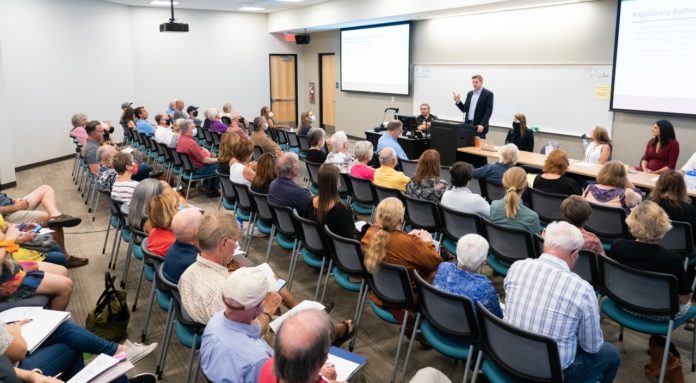
It was touted as a meeting to get the facts and share information and not a time to finger point.
Around 80 people attended in person — along with 80 online — a meeting Sept. 22 at Yavapai College’s Sedona Center to discuss short-term vacation rentals. The event was co-sponsored by the Sedona Chamber of Commerce and the Sedona Lodging Council.
“I wanted to have a meeting where people could get the facts,” said Steve Segner, president of the Lodging Council. “Today is not about saying short-term rentals are bad or good. We’re just saying we all ought to be on the same wavelength of understanding. We’re kind of locked into a corner. We’re going to have to live together. We’re going to have to work together.”
Sedona City Attorney Kurt Christianson kicked the meeting discussing what the city can and can’t legally do with short-term vacation rentals. He stressed that it’s more of the latter as a result of Senate Bill 1350, which prohibits cities and counties from banning short-term vacation rentals, aside from health and safety issues.
Prior to SB1350’s passage over five years ago, the city of Sedona had an ordinance banning the practice. Even though homes were illegally being used as short-term rentals, it wasn’t until after the bill went into effect that the numbers grew. The city estimates there are more than 1,100 vacation rentals in the greater Sedona area of the city, Oak Creek Canyon and the Village of Oak Creek.
Over the years, legislation has been proposed to give some control back to municipalities to regulate vacation rentals, only to have them fail to get enough backing. Cities are now allowed to require emergency contact information from the homeowners, which in Sedona has been successful with more than 85% of rentals. Failure to do so can result in citation — of which around 40 have been issued.
While vacation rentals are allowed, homeowners associations can ban them via their bylaws, but that hasn’t always been successful. Christianson said bans only work if an HOA has sufficient funds to hire attorneys to fight an owner of a short-term rental. And, it only works if the HOA has prohibitions on short-term rentals on the books. While many of the newer developments do, many older ones do not.
City Manager Karen Osburn said that while a city can regulate where a hotel can be built, what it looks like, safety standards and parking requirements, there are no such regulations when it comes to short-term rentals, other than something that may be a health or safety concern to the public.
“In terms of the loss of neighbors and neighborhoods, when we’re looking at particular segments of our community where we have 10% to 20% to 30% or more of those residential units converted to short-term rentals, that does change the character of the community,” Osburn said. “There is no question or debate about that. Even if our visitors who are renting short-term rentals are polite and respectful, they are not neighbors. When you no longer have neighbors and no longer have neighborhoods, you no longer have a community — you have one big resort.”
On the other hand, Osburn noted that taxes are collected from many of these short-term rentals, specifically those that go through online booking platforms, and that it’s often the case that the owners have made aesthetic modifications to the homes because there is competition among rentals.
Osburn also touched upon the housing crisis that the city is currently experiencing. She said this has gone from bad to worse as long-term housing units, which may have been rented by those in the workforce, are now short-term rentals and thus, workers have to find housing elsewhere. The result has been that when one of the few long-term rentals go on the market, the cost is much higher than it would have been just a couple years ago.
Sedona Chamber President and CEO Candace Carr Strauss said that while larger cities in the state may not be seeing the same erosion of neighborhoods, that’s not the case for smaller communities.
“Here, as a destination, everywhere is attractive,” she said. “I do believe that you can’t manage something you have no control over. We have very little ability to control the impacts of short-term rental conversions. Right now, all we can do is mitigate some of those issues.”
Strauss touched briefly upon the Sustainable Tourism Plan, the first of its kind in the state, which was a joint venture between in the city and chamber in 2019. It’s designed to shape the Sedona economy in ways that balance long-term sustainability and vibrancy while also focusing on residents as well. She said tourism is a $1 billion industry in Sedona as a result of nearly 3 million annual visitors. Two of the top three contributors to the city’s budget are sales and bed tax, of which visitors pay 77%.
Strauss reiterated that the meeting was not designed to be for or against short-term vacation rentals, but pointed to the challenges of managing an industry where little management is afforded. For example, when it comes to traditional lodging in the greater Sedona area, there are 4,391 rooms. Of those, only 623 have been added in the last two decades. She said the current vacation rental inventory is 1,323 units, of which 976 are whole-home rentals. Using a formula of 2.9 rooms for just the whole-home rentals, that’s 2,830 new rooms in the last five years.
The final speaker was Jim Bizely, the CEO of vacation rental corporation that manages 120 vacation rentals in Sedona as well as those in Park City, Utah, Austin, Texas, and Hawaii. He said like most local businesses, finding employees and housing for them to live in has been a challenge. But he said that’s been the case in all the cities where they manage rentals.
“Over the past three years we’ve seen the same type of thing where people are getting pushed out, while at the same time the cost of real estate has gone berserk in every vacation destination,” he said. “We’ve seen a spike in demand for vacation rentals because COVID or no COVID, people want to be with their families.
“For us, personally, we’re trying to make it a very luxurious product, while trying to do it responsibly. We get the TPT [Transaction Privilege Tax] licensing while making sure the homes are safe.”
He later added, “What we’re trying to do as a vacation rental manager here in Sedona — with three million visitors — is that we don’t want any more tourists but what we’re striving for is the quality of tourism in Sedona to increase.”
The entire meeting can be seen below.




















